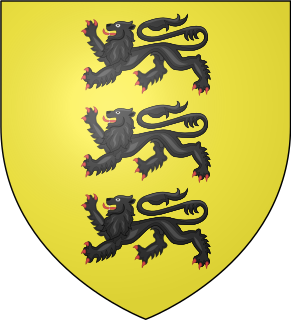Related Research Articles
There have been five Dunbar Baronetcies; the first four in the Baronetage of Nova Scotia, and the last in the Baronetage of the United Kingdom. There is also a Hope-Dunbar Baronetcy of Baldoon.
There have been 19 baronetcies created for persons with the surname Campbell, seven in the Baronetage of Nova Scotia and twelve in the Baronetage of the United Kingdom.

The Cumming-Gordon, later Gordon-Cumming Baronetcy, of Altyre near Forres, is a title in the Baronetage of the United Kingdom. It was created on 27 May 1804 for Alexander Cumming-Gordon, formerly Member of Parliament for Inverness Burghs. The Cumyn or Cumming family had been settled in Scotland since the 12th century. One member of the family, John II Comyn, Lord of Badenoch, married Eleanor, sister of King John of Scotland. Their son John III Comyn, Lord of Badenoch, known as the "Red Comyn", was a claimant to the Scottish throne through his mother. A later member of the family, Robert Cumming, 13th of Altyre, married Lucy, daughter of Sir Ludovic Gordon of Gordonstoun. Their great-grandson was the first Baronet, who assumed the additional surname of Gordon on succeeding to the Gordon of Gordonstoun estates. The second Baronet sat as Member of Parliament for Elgin Burghs. He changed the family surname from Cumming-Gordon to Gordon-Cumming. The fourth Baronet is best known as a central figure in the Royal Baccarat Scandal.
There have been six Baronetcies created for persons with the surname Brown, one in the Baronetage of Nova Scotia, one in the Baronetage of England, two in the Baronetage of Great Britain and two in the Baronetage of the United Kingdom. Two creations are extant as of 2010.
Nineteen baronetcies have been created for persons with the surname Hamilton, eight in the Baronetage of Nova Scotia, one in the Baronetage of England, five in the Baronetage of Ireland, one in the Baronetage of Great Britain and four in the Baronetage of the United Kingdom. As of 2008 two creations are extant, two are dormant, two are either extinct or dormant and twelve extinct.
There have been ten baronetcies created for persons with the surname Mackenzie, seven in the Baronetage of Nova Scotia and three in the Baronetage of the United Kingdom. Four of the creations are extant as of 2010.
There have been a number of creations of baronetcies with the surname Inglis. They are listed in order of creation.
There have been five baronetcies created for people with the surname Napier, three in the Baronetage of England, one in the Baronetage of Nova Scotia and one in the Baronetage of the United Kingdom. As of 2014 two of the creations are extant.
There have been five Baronetcies created for people with the surname Forbes, four in the Baronetage of Nova Scotia and one in the Baronetage of the United Kingdom. The first holder of the Burn Baronetcy of Jessfield, created in the Baronetage of the United Kingdom in 1923, assumed the surname of Forbes-Leith of Fyvie in 1925.
There have been three baronetcies held by people with the surname Lindsay, one in the Baronetage of Nova Scotia and two in the Baronetage of the United Kingdom. One creation is extant.

There have been four baronetcies created for persons with the surname Hope, three in the Baronetage of Nova Scotia and one in the Baronetage of the United Kingdom. As of 2010 one creation is extant, one dormant and two extinct.

There have been four baronetcies created for persons with the surname Gilmour, two in the Baronetage of Nova Scotia and two in the Baronetage of the United Kingdom. The former two are extinct and the latter two are extant.

There have been seventeen baronetcies for persons with the surname Stewart, ten in the Baronetage of Nova Scotia, one in the Baronetage of Ireland and six in the Baronetage of the United Kingdom. See also Steuart baronets, Henderson-Stewart baronets, MacTaggart-Stewart baronets and Stewart-Clark baronets.
There have been four baronetcies created for persons with the surname FitzGerald, one in the Baronetage of Ireland and three in the Baronetage of the United Kingdom.
Six baronetcies have been held by Grants.
The Vyvyan Baronetcy of Trelowarren, Cornwall is a title in the Baronetage of England. It was created on 12 February 1645 for Richard Vyvyan, a member of Parliament for Penrhyn, Tregony and St Mawes and Master of the Mint. His eldest son, the second Baronet, represented St Mawes and Helston in the House of Commons. He was succeeded in 1697 by his son, the third Baronet, was a member of Parliament for Mitchell and Cornwall and a prominent Jacobite. The eighth Baronet sat as Conservative Member of Parliament for Cornwall, Okehampton, Bristol and Helston. His grandson, the tenth Baronet, was a Colonel in the British Army. As of 28 February 2014, the present Baronet has not successfully proven his succession and is therefore not on the Official Roll of the Baronetage, with the baronetcy considered dormant since 1995.

There have been three baronetcies created for persons with the surname Carew, two in the Baronetage of England prior to 1707, one in the Baronetage of Great Britain.
There have been six baronetcies created for persons with the surname Home, five in the Baronetage of Nova Scotia and one in the Baronetage of the United Kingdom. Only one creation is extant as of 2008.
There have been five baronetcies created for members of Clan Ramsay, four in the Baronetage of Nova Scotia and one in the Baronetage of the United Kingdom. The baronetcy in the Baronetage of the United Kingdom is extant as of 2020.

Sir Alexander Cumming, 1st Baronet (c.1670–1725) of Culter, Aberdeen, was a Scottish landowner and Tory politician who sat in the House of Commons from 1709 to 1722.
References
- ↑ Cokayne, George Edward, ed. (1904), Complete Baronetage volume 4 (1665-1707), 4, Exeter: William Pollard and Co, retrieved 2 February 2019